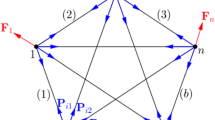Abstract
Shape optimization in a general setting requires the determination of the optimal spatial material distribution for given loads and boundary conditions. Every point in space is thus a material point or a void and the optimization problem is a discrete variable one. This paper describes various ways of removing this discrete nature of the problem by the introduction of a density function that is a continuous design variable. Domains of high density then define the shape of the mechanical element. For intermediate densities, material parameters given by an artificial material law can be used. Alternatively, the density can arise naturally through the introduction of periodically distributed, microscopic voids, so that effective material parameters for intermediate density values can be computed through homogenization. Several examples in two-dimensional elasticity illustrate that these methods allow a determination of the topology of a mechanical element, as required for a boundary variations shape optimization technique.
Similar content being viewed by others
References
Avellaneda, M. 1987: Optimal bounds and microgeometries for elastic two-phase composites.SIAM J. Appl. Math. 47, 1216–1228
Bendsøe, M.P. 1983: On obtaining a solution to optimization problems for solid, elastic plates by restriction of the design space.J. Struct. Mech. 11, 501–521
Bendsøe, M.P. 1986: Generalized plate models and optimal design. In: Eriksen, J.L.; Kinderlehrer, D.; Kohn, R.; Lions, J.-L., (eds.)Homogenization and effective moduli of materials and media, the IMA volumes in mathematics and its applications, pp. 1–26. Berlin, Heidelberg, New York: Springer
Bendsøe, M.P.; Kikuchi, N. 1988: Generating optimal topologies in structural design using a homogenization method.Comput. Meth. Appl. Mech. Engrg. 71, 197–224
Bendsøe, M.P.; Rodrigues, H.C. 1989: Integrated topology and boundary shape optimization of 2-D solids.MAT-Report No.1989–14, Math. Inst., Techn. Univ. of Denmark, DK-2800 Lyngby
Bensousson, A.; Lions, J.-L.; Papanicolaou, G. 1978:Asymptotic analysis for periodic structures. Amsterdam: North-Holland
Bourgat, J.F. 1977: Numerical experiments of the homogenization method for operators with periodic coefficients.Lecture Notes in Mathematics 704, pp. 330–356, Berlin, Heidelberg, New York: Springer
Cheng, K.T.; Olhoff, N. 1982: Regularized formulation for optimal design of axisymmetric plates.Int. J. Solids Struct. 18, 153–170
Ding, Y. 1986: Shape optimization of structures: a literature survey.Comp. Struct. 24, 985–1004
Goodman, J.; Kohn, R.V.; Reyna, L. 1986: Numerical study of a relaxed variational problem from optimal design.Comp. Meth. Appl. Mech. Engrg. 57, 107–127
Haftka, R.T.; Gandhi, R.V. 1986: Structural shape optimization- a survey.Comp. Meth. Appl. Mech. Engrg. 57, 91–106
Kohn, R.V.; Strang, G. 1986a: Optimal design and relaxation of variational problems.Comm. Pure Appl. Math. 39, 1–25 (Part I), 139–182 (Part II), and 353–377 (Part III)
Kohn, R.V.; Strang, G. 1986b: Optimal design in elasticity and plasticity.Int. J. Numer. Meth. Eng. 22, 183–188
Lurie, K.A.; Fedorov, A.V.; Cherkaev, A.V. 1982: Regularization of optimal design problems for bars and plates. Parts I and II.J. Optim. Theory Appl. 37, 499–521, 523–543
Olhoff, N.; Lurie, K.A.; Cherkaev, A.V.; Fedorov, A.V. 1981: Sliding regimes and anisotropy in optimal design of vibrating axisymmetric plates.Int. J. Solids Struct. 17, 931–948
Olhoff, N.; Taylor, J.E. 1983: On structural optimization.J. Appl. Mech. 50, 1134–1151
Pedersen, P. 1989a: On optimal orientation of orthotropic materials.Struct. Optim. 1, 101–106
Pedersen, P. 1989b: Bounds on elastic energy in solids of orthotropic materials.DCAMM Report No.392, Techn. Univ. of Denamrk, DK-2800 Lyngby
Rossow, M.P.; Taylor, J.E. 1973: A finite element method for the optimal design of variable thickness sheets.AIAA J. 11, 1566–1569
Rozvany, G.I.N. 1984: Structural layout theory - the present state of knowledge. In: Atrek, E.; Gallagher, R.H.; Ragsdell, K.M.; Zienkiewicz, O.C. (eds.)Directions in optimum structural design, Chapter 7. Chichester: Wiley & Sons
Rozvany, G.I.N.; Ong, T.G.; Szeto, W.T.; Olhoff, N.; Bendsøe, M.P. 1987: Least-weight design of perforated plates.Int. J. Solids and Struct. 23, 521–536 (Part I), 537–550 (Part II)
Rozvany, G.I.N. 1989: Optimality criteria for continuous and segment-wise linear distribution of the cross-sectional parameters. In: Eschenauer, H.A.; Thierauf, G. (eds.)Discretization methods and structural optimization - procedures and applications, pp. 291–298. Berlin, Heidelberg, New York: Springer
Sanchez-Palencia, E. 1980: Non-homogeneous media and vibration theory.Lecture Notes in Physics 127, Berlin, Heidelberg, New York: Springer
Author information
Authors and Affiliations
Rights and permissions
About this article
Cite this article
Bendsøe, M.P. Optimal shape design as a material distribution problem. Structural Optimization 1, 193–202 (1989). https://doi.org/10.1007/BF01650949
Received:
Issue Date:
DOI: https://doi.org/10.1007/BF01650949




